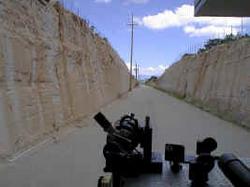One If by Land, Zero If by Sea

Paul Revere received his famous binary message across the Charles River, according to the Longfellow poem, but now physicists would like to send secret light signals even farther: from the ground to a satellite. The light signal would be the “key” for decoding some encrypted message transmitted by other means. Light keys are based on the principles of quantum mechanics and are the most secure because the security is based on the laws of nature, rather than the difficulty of solving a mathematical problem. Quantum keys have been successfully distributed over many kilometers using fiber optic cables, but delivering a key through the atmosphere is more challenging. The 12 October PRL describes a successful quantum key distribution (QKD) system over about a kilometer outdoors, which researchers say is a crucial step toward the goal of safely transmitting the key from Earth to a satellite.
The sequence of numbers that makes up a quantum key is represented by single photons, each having a particular polarization corresponding to a 1 or 0 of the binary sequence. When transmitting outdoors, turbulence in the air can easily make the photons wander from their prescribed path, making single photons extremely difficult to detect. Moreover, stray photons from moonlight or sunlight can overwhelm the signal from the single photon to be detected. Two years ago, however, researchers from Johns Hopkins University successfully sent a quantum key over a distance of 75 m outdoors. Now William Buttler and his colleagues at the Los Alamos National Laboratory have extended that distance by more than ten times, to about a kilometer. This is important for communicating with a satellite because the most disruptive part of the atmosphere is the lowest few kilometers. Based on their result, the Los Alamos team calculates that a quantum key could be sent to a satellite about 300 km above the Earth.
During the night, the researchers set up a transmitter system (dubbed Alice) and a receiver system (called Bob) near one another, facing a mirror placed 500 m away. Alice sent out a stream of photons; those that were horizontally polarized represented 0s, and those that were right-circular-polarized represented 1s. Bob received the reflected photons and tested for 1s and 0s. According to established rules for quantum cryptography, this system provides Bob and Alice with a sequence of bits that is known only to them and cannot be intercepted.
To insure intact transmission of the photons over the long distance, Buttler and his colleagues used several novel techniques. For example, the photon beam had a large diameter (5 cm ), and the pulses were short, lasting only about 1 nanosecond, which allowed the researchers to reject light that did not arrive at the receiver within that short time interval. They also used a wavelength of 772 nm , at which the atmosphere is essentially transparent. The receiver was the first of its kind to “passively” perform an analysis in free space, without first coupling the photons into an optical fiber. They achieved further noise reduction by rejecting photons on the basis of where they came from, so that only photons from the transmitter were accepted.
Charles Bennett, of the IBM Research Laboratory in Yorktown Heights, New York, says that the Los Alamos experiments are “noteworthy in perfecting the optics needed for free space QKD.” This is important, he adds, because it will probably be the “most practical way to share a secure key over long distances, especially between the surface and orbiting satellite stations.”
–Meher Antia
Meher Antia is a freelance science writer.


